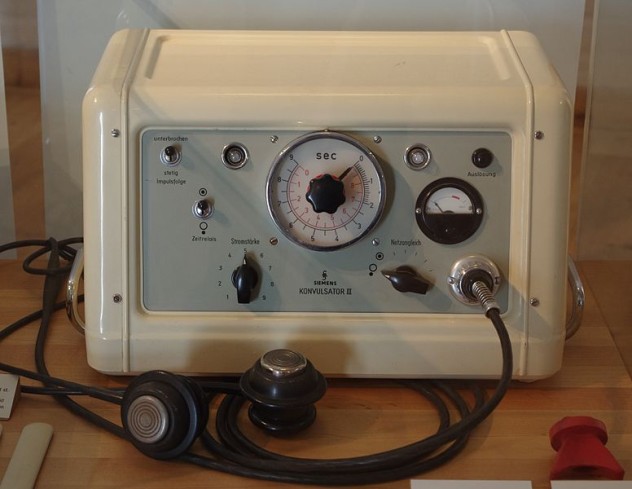 Politics
Politics  Politics
Politics  Weird Stuff
Weird Stuff Ten Bizarre Facts About The Doge Meme
 Our World
Our World 10 Ways Your Christmas Tree Is More Lit Than You Think
 Movies and TV
Movies and TV The 10 Coolest Stars to Set Sail on The Love Boat
 History
History 10 Things You Didn’t Know About the American National Anthem
 Technology
Technology Top 10 Everyday Tech Buzzwords That Hide a Darker Past
 Humans
Humans 10 Everyday Human Behaviors That Are Actually Survival Instincts
 Animals
Animals 10 Animals That Humiliated and Harmed Historical Leaders
 History
History 10 Most Influential Protests in Modern History
 Creepy
Creepy 10 More Representations of Death from Myth, Legend, and Folktale
 Politics
Politics 10 Political Scandals That Sent Crowds Into the Streets
 Weird Stuff
Weird Stuff Ten Bizarre Facts About The Doge Meme
 Our World
Our World 10 Ways Your Christmas Tree Is More Lit Than You Think
Who's Behind Listverse?

Jamie Frater
Head Editor
Jamie founded Listverse due to an insatiable desire to share fascinating, obscure, and bizarre facts. He has been a guest speaker on numerous national radio and television stations and is a five time published author.
More About Us Movies and TV
Movies and TV The 10 Coolest Stars to Set Sail on The Love Boat
 History
History 10 Things You Didn’t Know About the American National Anthem
 Technology
Technology Top 10 Everyday Tech Buzzwords That Hide a Darker Past
 Humans
Humans 10 Everyday Human Behaviors That Are Actually Survival Instincts
 Animals
Animals 10 Animals That Humiliated and Harmed Historical Leaders
 History
History 10 Most Influential Protests in Modern History
 Creepy
Creepy 10 More Representations of Death from Myth, Legend, and Folktale
10 Crazy Cases Of People Wrongfully Committed To Insane Asylums
If you suddenly woke up inside a mental hospital, do you think you could convince everyone that you’re not crazy and to let you go home? Convincing the world you’re sane may not be as easy as you think. It is shockingly easy in the United States and around the world to be wrongfully and involuntarily committed to an insane asylum.
10 Banking Conspiracy Theorist

Gustl Mollath was an ordinary German man who made a living by restoring vintage cars. But then he stumbled upon a banking conspiracy so grand that the world thought he was crazy enough that he was institutionalized for seven years.
While Mollath made a humble living working on cars, his wife worked at one of Germany’s largest banks, HypoVereinsbank. It was through his wife and her work that Mollath discovered a massive tax evasion scheme undertaken by the German bank. Mollath’s discovery quickly caused conflict in the marriage. After allegations of domestic violence between the couple, the marriage was heading for divorce. Mollath took what he knew about the bank’s tax evasion scheme to the German public. He then filed a large criminal complaint against HypoVereinsbank and its employees—including his wife. He claimed that HypoVereinsbank was making illicit money transfers to Switzerland that would soon be labeled money laundering.
At first, the German media ignored Mollath’s claims, but the German authorities did not. Mollath’s wife went forward with the divorce and told the authorities that he had slashed her tires. She also claimed that he was abusive following his discovery of the banking conspiracy. German prosecutors charged Mollath and used his criminal complaint against HypoVereinsbank as “evidence that he suffered from paranoid delusions.” They successfully had him involuntarily committed to a mental hospital.
Though Mollath remained locked away in an insane asylum, not everyone thought he was crazy. Bloggers, activists, and conspiracy theorists began to investigate Mollath’s claims against HypoVereinsbank and found them to be correct.
Many years later, an internal report by HypoVereinsbank that proved the tax evasion and money laundering scheme was leaked to the public by a German newspaper. Mollath’s claims were found to be true and led to HypoVereinsbank being raided by German police on suspicion of tax fraud. Mollath was released from the mental hospital by a court.
9 NYPD Whistle-Blower
Adrian Schoolcraft was a New York Police Department (NYPD) cop. That is, until he decided he had to take a stand against corruption in the NYPD.
Officer Schoolcraft first started his effort to expose wrongdoings by his fellow NYPD officers in 2008. He secretly taped conversations among the NYPD from 2008 to 2009. The tapes contained evidence of widespread corruption that included the use of illegal arrest quotas that led to many wrongful arrests in New York City.
As Schoolcraft began compiling his tapes and voicing his dissent, he began experiencing harassment from other officers in the NYPD. When Officer Schoolcraft took his concerns to his superiors, they dismissed his claims and suggested that Schoolcraft was losing his mind. They recommended that he be given psychological treatment. When Officer Schoolcraft did meet with an NYPD psychologist, the psychologist made him surrender his weapons and Schoolcraft was reassigned to a menial desk job.
Schoolcraft persevered with his allegations of corruption and got his claims to the NYPD Internal Affairs Bureau. The NYPD responded by putting Schoolcraft under “forced monitoring.” Soon after, an NYPD lieutenant confiscated the notes Schoolcraft had compiled as evidence of the corruption. Schoolcraft then received a call from his father, a former policeman himself, warning him about actions the NYPD may take against him. Mere hours later, members of the NYPD invaded Schoolcraft’s apartment after obtaining the key by telling Schoolcraft’s landlord that he was suicidal.
Just before the NYPD officers raided Schoolcraft’s apartment, he turned on two tape recorders to record the incident. After the NYPD officers broke into Schoolcraft’s apartment, they interrogated him before handcuffing him, taking him away, and involuntarily committing him to psychiatric ward in the nearby Jamaica Hospital Medical Center.
Schoolcraft was held in the psychiatric ward against his will. He was handcuffed to his bed and prevented from using the telephone to call for help at the orders of the NYPD.
After six days, Schoolcraft was able to leave the mental hospital and promptly filed a lawsuit against the NYPD and the mental hospital that held him against his will at the nefarious orders of the police. After his release, Schoolcraft was indefinitely suspended without pay from the NYPD. NYPD officers continued monitoring Schoolcraft and visiting him at his apartment for multiple weeks. Schoolcraft’s allegations of corruption, arrest quotas, and underreporting among the NYPD were later vindicated by the Village Voice.
8 The USSR’s Critics

The Soviet Union had a problem with its treatment of its dissidents and with its psychiatric practices that resulted in widespread abuse of the mental health system. During the 1960s and ’70s, the USSR systematically diagnosed its critics with mental illnesses in order to discredit them and move them from the general population to insane asylums.
The USSR even invented psychological conditions including “delusion of reformism,” and “sluggish schizophrenia.” The condition of sluggish schizophrenia was invented so that people could be diagnosed with schizophrenia even if no signs or symptoms were evident. One Soviet dissident, Valery Tarsis, was wrongfully diagnosed and forcefully committed to an insane asylum after he smuggled his novel The Bluebottle—which was critical of the USSR government—out of the Soviet Union to have it published.
Tarsis spent eight months locked away in a Soviet mental hospital. During his time there, he wrote one of the first literary works to address the USSR’s nefarious use of psychiatry, an autobiographical novel entitled Ward 7.
Soviet poet Jospeh Brodsky was also committed against his will in the same year as Tarsis, 1963. Brodsky was accused by Soviet officials of pursuing a “parasitic way of life.” He was diagnosed insane and forcibly institutionalized. Brodsky endured a horrendous treatment, being forcibly injected with tranquilizers and woken in the middle of the night by being immersed in cold water. He spent a total of 18 months in the insane asylum.
7 Pain Medication Side Effects

Back in 1993, a Nebraska man named John Montin took some pain medication to try to manage his chronic back pain. This action inadvertently got him committed to an insane asylum.
According to the psychiatrist who evaluated Montin, the pain medication he took induced a temporary psychosis. This dazed state caused Montin to go knock on the door of a rural Nebraska home and try to “take ownership of it” by claiming it belonged to his ancestors.
Accounts of what happened next differ drastically. Nebraska police initially claimed that Montin engaged in an 11-hour shoot-out with the cops that resulted in no injuries to either party. However, at Montin’s trial, the owners of the home were alleged to have pulled shotguns on a dazed Montin, which prompted Montin to hide in a nearby ditch overnight.
Most of the charges levied against Montin were dropped by prosecutors. Jurors presiding over the trial acquitted Montin of the remaining attempted murder and weapons charges. The jurors also cleared Montin of the charge of false imprisonment and use of a weapon “by reason of insanity.” Based upon police reports of Montin’s behavior during the incident, Montin was then involuntarily committed to a mental hospital.
When the affects of his back pain medication wore off hours after the incident, Montin was no longer insane. But when Montin was involuntarily committed to the psychiatric ward in Lincoln Regional Center Hospital, his psychiatrists never bothered to evaluate him to determine if he was still insane and worthy of being involuntarily and indefinitely committed to their psych ward. Instead, they relied upon the police reports of his behavior during the incident.
Montin remained involuntarily committed in that psychiatric ward for 20 years until he was finally able to convince a doctor in the hospital to reevaluate him. After examining him and hearing his story, Montin was found to be sane after all and released. Montin subsequently sued that Nebraska mental hospital for $33 million. The case has not yet been settled.
6 Anti-Segregation Activist

As a history professor at Alcorn State University, Clennon Washington King Jr. had an inside view of the racially segregated school system in 1950s Mississippi. Professor King began to attract attention from the public in 1957 when he wrote letters to the editors of local newspapers advocating for the end of racial segregation in schools, prompting some pro-segregation Mississippians to threaten to boycott Alcorn University.
Professor King was unfazed and continued to fight segregation. In 1958, he tried to enroll one of his own children in an all-white elementary school. His attempts were unsuccessful, and his wife and children ended up fleeing for fear of retaliation in the racially charged South.
Later that year, King, the well-qualified academic, tried to enroll himself into the University of Mississippi. The only problem was that in 1958, the University of Mississippi didn’t allow African Americans like King into their college. Not only was he rejected, but university officials literally thought he was crazy for trying to enroll at a university that barred black men. King was committed to an insane asylum as a result. Fortunately, his brother was able to free him after a 12-day stint in the mental institution.
Two years later, James Meredith succeeded where Professor King could not and became the first black student to enroll in the University of Mississippi.
King would later run as a presidential candidate in the 1960 presidential campaign for the Independent Afro-American Party. He received 1,485 votes in Alabama, making him the first black presidential candidate in the United States to run as a party nominee.
5 The Surveiled Honors Student

Sophia Chinemerem Eze emigrated from Nigeria to New York City to attend Brooklyn College as an international honors student, but her American dream turned into a waking nightmare.
The trouble for Eze began in her off-campus apartment, where she was suspicious that her former landlords and roommates were engaging in “potentially criminal activity” and defaming her on the Internet. Most startlingly of all, she thought that her landlord had installed a hidden camera in her bedroom.
Eze took her concerns to her college’s security and psychiatrist, but they didn’t believe her and offered her no help, even after she purportedly discovered a hidden camera inside her bedroom. Despite the fact that Ms. Eze had no history of mental illness, she was forced into an ambulance by school personnel against her will and taken to the psychiatric ward of a Kings County Hospital without her consent. She was then involuntarily committed and held for two weeks in that psychiatric ward.
When she was eventually released from the psychiatric ward, staff at Brooklyn College allegedly did not allow Eze to complete her final examinations. Eze has since transferred out of Brooklyn College.
Ms. Eze filed a lawsuit against the company that owned the mental facility that wrongly committed her for two weeks and won $110,000. She has also filed a lawsuit against Brooklyn College.
4 China’s Dissidents

Similarly to the USSR, The People’s Republic of China has also made a habit out of labeling its dissidents insane and forcibly committing them into mental institutions. One such critic was Xu Lindong, a 50-year-old farmer with a fourth grade education who spent his whole life working on his farm.
Lindong tried to help his illiterate neighbor claim ownership of a small piece of land next to her home and filed on her behalf to obtain the small plot. After the claim was rejected in a Chinese court, Lindong sent petitions to government officials to try to find someone who would help his neighbor.
The Chinese government took notice of his grievances but didn’t exactly address them. Instead, they decided that he and his grievances were insane and had him involuntarily committed to a mental hospital—despite the fact that he showed no signs or history of mental illness.
While Lindong was locked away in that mental hospital, he was given 54 brutal electro-shock treatments. He was also forcibly restrained and given medications against his will. He felt so hopeless that he tried to commit suicide three times. Xu Lindong ended up spending 6.5 years in two different mental hospitals until he was released after his brother was able to get a journalist to publish his story in the local press.
Lindong’s case isn’t out of the ordinary in China. Other cases include Xu Wu, a former security guard who petitioned the government in a wage dispute and was involuntarily committed for four years. Wu also faced electro-shock treatment and considered suicide.
3 Homosexuality As A Mental Illness

Psychiatry before the 20th century was considerably less scientific than it is now. The bizarre reasons one could be committed to an insane asylum included “laziness,” “bad whiskey,” “imaginary female trouble,” and “parents were cousins.” It was also common for gay and lesbian individuals to be committed for their attraction to members of the same sex and for young women to be committed for promiscuity if it was deemed that their sexual appetites were inappropriately voracious.
The practice had a longstanding influence. Until 1973, the American Psychiatric Association listed homosexuality as a mental disorder. One shockingly recent case of a lesbian being wrongly committed is that of an American named Lyn Duff, now a journalist. In 1991, at age 14, she came out publicly as a lesbian. Her mother did not take the news well. She took Duff from their California home to Rivendell Psychiatric Center in Utah and put the teen in treatment.
Once at the Utah mental hospital, Duff was visited by Mormon missionaries who considered her homosexuality a mental illness. Hospital staff tried to use conversion therapy on Duff. One of the most bizarre treatments Duff was subjected to was being forced to watch lesbian pornography while smelling ammonia in a Pavlovian attempt to make her straight. She was given psychotropic drugs, put under hypnosis, and sent into solitary confinement.
Duff spent a total of 168 days involuntarily committed in the mental hospital. She eventually escaped in May 1992 and fled to San Francisco. Soon after, she successfully had her mother’s parental rights terminated by a California court and was adopted by a lesbian couple in San Francisco.
2 Ex-Muslim Nigerian
Being an atheist is hard in Nigeria, an ardently Muslim country where 51 persent of Muslims believe that all those who leave the religion of Islam should be put to death. Mubarak Bala was one of those former Muslims, but instead of being put to death, he was deemed insane.
Bala first went public with his non-belief in Islam when he told his family that he had renounced the religion. After his family heard that Bala had left the religion of Islam, they took him to a doctor, thinking he could be mentally ill. The first doctor they saw found no signs of mental illness in Bala, but the family was able to convince a second doctor that Bala’s atheism was a form of mental illness and a “side effect of a personality change.” Bala was involuntarily committed into a psychiatric institution and forcibly drugged by the hospital staff.
Bala began using Twitter and email to call for help from the world while he was locked away in the mental institution. Eventually, a humanist charity was able to help get him freed, and Bala was released after being held for 18 days. Unfortunately, things didn’t get much better after he was released. He claimed to receive death threats and went into hiding.
1 The First Hand-Washing Doctor
Back in the 19th century, medicine was a far dirtier practice than it is today. Doctors wouldn’t wash their hands—even before delivering babies. When one lone doctor suggested that medical professionals should more rigorously wash their hands, the medical community thought he was crazy.
While practicing medicine in a German hospital, Doctor Ignaz Semmelweis raised an eyebrow when he saw his fellow doctors walk from the bedsides of dead or dying patients directly into the hospital’s maternity ward to deliver babies. Pretty soon, Dr. Semmelweis suggested that the doctors wash their hands before handling newborn babies to reduce rates of infant mortality. The medical community was outraged at the accusation that doctors were inadvertently causing some of their patients horrid deaths with their dirty hands. One of his many detractors was Doctor Carl Levy, who published a paper rebutting Semmelweis’s claims: “He is concerned only with general infection from corpses without respect to the disease that led to death. In this respect his opinion seems improbable.”
Ever persistent, Semmelweis argued with influential doctors—and was eventually dismissed from his position at Vienna General Hospital. Left ostracized from the medical community and without a job, Dr. Semmelweis became impoverished, his mental state deteriorating as he fell into a state of depression as a result of his abjuration.
Dr. Semmelweis was eventually committed to an insane asylum in 1865. He tragically died in that mental asylum of a blood infection after a violent beating by workers in the asylum when he demanded to be released. Dr. Semmelweis died at the age of 47, long before the medical community realized his zeal for hand washing wasn’t mad at all.
Twenty years after Semmelweis’s death, his theory received widespread acceptance after French microbiologist Louis Pasteur penned the theoretical framework for the germ theory of disease. Soon after, doctors began to heed Semmelweis’s advice and washed their hands before delivering babies. Unsurprisingly, the hand-washing practice has dramatically reduced infant mortality rates during childbirth.
As a lesson to us all, the term “Semmelweis reflex” was coined in response to Semmelweis’s tragic story. It refers to the reactionary reflex to reject new ideas or practices when they oppose established norms, theories, or beliefs.
Nathan is a freelance journalist and screenwriter.








